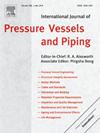Oxidation evolutions in different regions of 9Cr3W3Co martensitic steel welded joints exposed to oxygenated supercritical water at 650 °C
IF 3
2区 工程技术
Q2 ENGINEERING, MECHANICAL
International Journal of Pressure Vessels and Piping
Pub Date : 2025-04-17
DOI:10.1016/j.ijpvp.2025.105530
引用次数: 0
Abstract
The oxidation behaviors of 9Cr3W3Co steel welded joints exposed to supercritical water with dissolved oxygen of 300 ppb at 650 °C, 30 MPa for 50–1500 h were studied. The results showed that the grain boundary density of the weld metal was slightly greater than that of the equiaxed grain zone and significantly greater than that of the inter-critical zone and the base metal, but the fine grain band of the inter-critical zone had a larger percentage of the prior austenite grain boundaries. Different from the base metal and heat affected zone, the weld metal was virtually free of Cu. The higher grain boundary density promoted the growth of the internal oxide layer at the initial stage of oxidation, and accelerated the formation of continuous FeCr2O4 layer with the extension of oxidation time. Cu promoted the growth of outer layer of oxide film in heat affected zone and base metal, and delayed the formation of the continuous FeCr2O4 layer. Consequently, at the initial stage of oxidation, the oxide film formed in the equiaxed grain zone was the thickest. After long-time oxidation, the continuous FeCr2O4 layer was first formed in the weld metal, resulting in the thinnest oxide film of weld metal. In addition, the FeCr2O4 band formed along various boundaries led to the formation of wavy oxidation fronts in each sub region of the welded joint after long-time oxidation.
650℃含氧超临界水下9Cr3W3Co马氏体钢焊接接头不同区域的氧化演变
研究了9Cr3W3Co钢焊接接头在溶解氧为300 ppb、650℃、30 MPa、50 ~ 1500 h的超临界水中的氧化行为。结果表明:焊缝金属的晶界密度略大于等轴晶区,显著大于临界间区和母材,但临界间区的细晶粒带占原有奥氏体晶界的比例较大;与母材和热影响区不同,焊缝金属几乎不含Cu。较高的晶界密度在氧化初期促进了内部氧化层的生长,并随着氧化时间的延长加速了连续fer2o4层的形成。Cu促进了热影响区和母材氧化膜外层的生长,延缓了连续fer2o4层的形成。因此,在氧化初期,等轴晶区形成的氧化膜最厚。长时间氧化后,焊缝金属中首先形成连续的FeCr2O4层,形成焊缝金属最薄的氧化膜。此外,沿不同边界形成的FeCr2O4带,在长时间氧化后,导致焊接接头各子区域形成波浪形氧化锋。
本文章由计算机程序翻译,如有差异,请以英文原文为准。
求助全文
约1分钟内获得全文
求助全文
来源期刊
CiteScore
5.30
自引率
13.30%
发文量
208
审稿时长
17 months
期刊介绍:
Pressure vessel engineering technology is of importance in many branches of industry. This journal publishes the latest research results and related information on all its associated aspects, with particular emphasis on the structural integrity assessment, maintenance and life extension of pressurised process engineering plants.
The anticipated coverage of the International Journal of Pressure Vessels and Piping ranges from simple mass-produced pressure vessels to large custom-built vessels and tanks. Pressure vessels technology is a developing field, and contributions on the following topics will therefore be welcome:
• Pressure vessel engineering
• Structural integrity assessment
• Design methods
• Codes and standards
• Fabrication and welding
• Materials properties requirements
• Inspection and quality management
• Maintenance and life extension
• Ageing and environmental effects
• Life management
Of particular importance are papers covering aspects of significant practical application which could lead to major improvements in economy, reliability and useful life. While most accepted papers represent the results of original applied research, critical reviews of topical interest by world-leading experts will also appear from time to time.
International Journal of Pressure Vessels and Piping is indispensable reading for engineering professionals involved in the energy, petrochemicals, process plant, transport, aerospace and related industries; for manufacturers of pressure vessels and ancillary equipment; and for academics pursuing research in these areas.

 求助内容:
求助内容: 应助结果提醒方式:
应助结果提醒方式:


